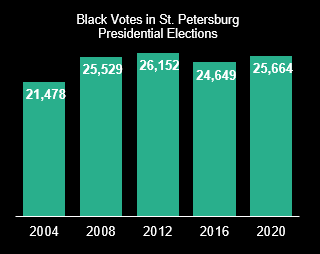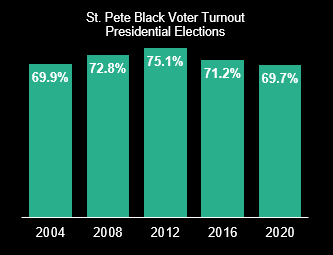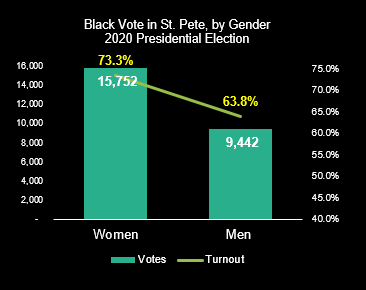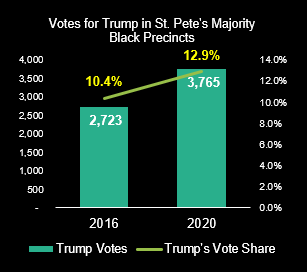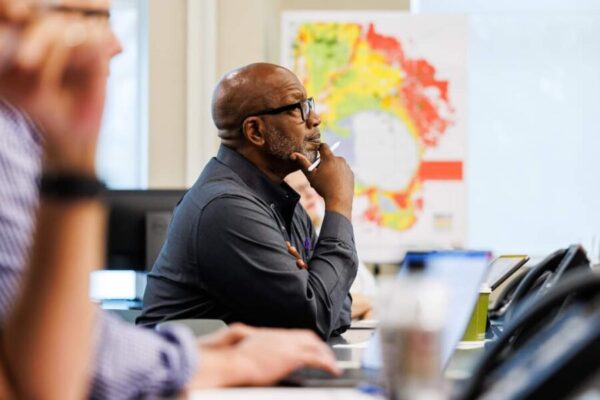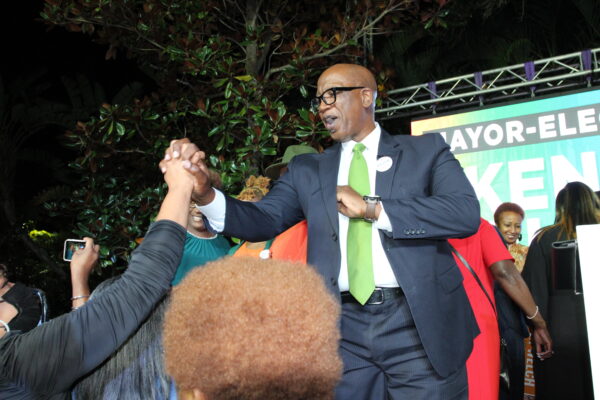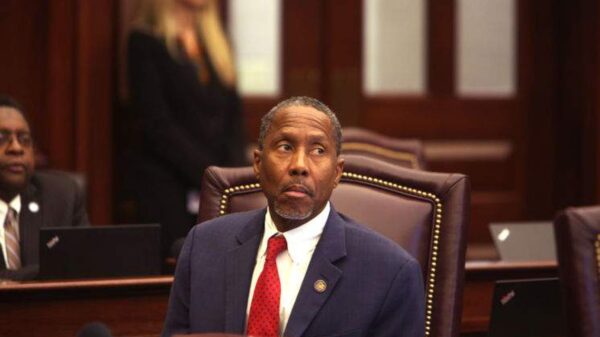News
Some ‘Splaining to do re St. Pete’s Black Vote 2020; 10 Facts that Say Dems Unprepared for the Next Big Election

From Politico, “With Florida vote tightening, a last-minute push aimed at Black voters,” then Democratic vice presidential candidate Kamala Harris speaks at a drive-in rally in Florida
-By Gypsy C. Gallardo
African Americans in Pinellas County turned in their highest vote count ever in the 2020 Presidential Election, contributing mightily to one of the few Joe Biden victories in all of Florida, a state Trump won. Yet, black voting patterns changed dramatically in St. Petersburg, which is home to over 60% of Pinellas County’s African American population. And not for the better.
Though black St. Petersburg scored its second-best vote count ever this November, don’t let that masquerade an otherwise perplexing showing from a community famous for its election cycle sizzle.
In point of fact, black St. Petersburg just had its weakest turnout in a presidential contest, in the 21st century.
This year’s results stand in stark contrast to the 30 years of nearly uninterrupted political gains by African Americans in St. Pete since the famous 1993 mayoral contest between then Mayor David Fischer and ousted police chief Ernest Curtsinger, who was fired the year before by then City Administrator Don McRae (a black man), for racism on the job.
That was the first time the black vote roared in St. Petersburg. And it’s picked up speed ever since. Prior to 2016, African Americans in St. Pete had increased their vote count and turnout rate in 10 of the 11 general election cycles, from 2004 onward.
But that track record came to an abrupt halt this November, which should give Democrats pause. Despite the millions of dollars and tens of thousands of paid and volunteer time invested to activate black voters in St. Petersburg for the 2020 election, black turnout was at its lowest level since the year 2000. Not only that, Republican incumbent Donald Trump grew his vote share in the City’s majority-black precincts.
And St. Petersburg’s black community wasn’t an anomaly. Before and after the election, reports began to surface about weaker-than-expected turnout in other areas with large African American populations. Here in Florida, most damning were reports of dim turnout in Broward and Miami-Dade counties (where nearly 30% of Florida’s black population resides).
Black leaders are beginning to speak out about the reasons for the shortfall. In a HuffPost article on November 20th, Wisconsin’s Black Lt. Gov. Mandela Barnes blamed lack of interest in Milwaukee’s heavily-black precincts on a combination of voter suppression and disinformation efforts by Republicans, along with the failure of Democrats to embrace bold ideas such as “Medicare for All.”
Here in Florida, several black electeds have gone on the record about the shortcomings in organizing efforts in black and Latino areas (including State Senators Perry Thurston and Oscar Braynon, and U.S. Congresswoman Frederica Wilson).
Some grassroots political leaders lay the problems squarely at the feet of the Florida Democratic Party (including Pinellas County’s Ashley Green and Palm Beach County’s Charles Ridley). Unscientific polls of St. Pete activists point to Russian disinformation, the pull of celebrity rappers who endorsed or played footsie with Trump, and fatigue with the milk toast posture of the Democrats on issues such as police reform, healthcare costs, and student loan debt.
Whatever the root causes, Democrats face a reckoning prior to the next midterm election. Black St. Petersburg presents an ideal case study of the fast-changing black voting patterns in some parts of the country.
Not least because African Americans in St. Pete are the Democrats’ most strident supporters in a county that’s picked the winner in all but one presidential election since 1980. They are also one of the most active and dynamic voting blocs in the battleground state of Florida.
Here are 10 facts about St. Pete’s black vote in 2020 that tell a story of underlying strength but major challenges for Democrats hoping to win against Republican Governor Ron DeSantis in 2022.
First, the good news
1. Across Pinellas County, the black vote count was higher than it’s ever been
African Americans turned in over 42,000 votes countywide, overwhelmingly for Biden, contributing to the president-elect’s razor thin margin over Trump (1,241) in one of only 12 Florida counties that voted blue.
2. African Americans in St. Petersburg had their 2nd best vote count in history
Black voters in St. Pete had their second-highest vote count ever in the 2020 general; 25,664 African Americans voted, which was 4% growth over 2016 (but fell just shy of their record high vote total in 2012).
3. The push to get new voters registered was modestly successful, (including ex-felons)
Democrats had hoped the passage of Amendment 4 would lead to a wave of new voter registrations this cycle. Indeed, St. Pete had 2,200 black registrants added to the rolls, compared to 2016. Just over 36,800 African Americans were registered in St. Pete in time for the recent election. That’s a decent showing, but not as large as the jump in black registrations leading up to the 2008 election. From 2004 and 2008, African American registrations jumped by 4,300.
The Not So Good News
4. Black St. Petersburg had its weakest turnout in a presidential election, in the 21st century
In the 2020 general election, St. Pete’s African American voters had their lowest turnout rate, as far back as the Supervisor of Election has demographics available: 69.7% of registered black voters showed up this year. It was the second presidential cycle in a row when the black turnout rate dropped in St. Petersburg.
5. For the first time, Latino voters and other people of color outdid African Americans in turnout
Black voters have long had higher turnout rates than Latinos, Asians and other people of color in St. Petersburg. Until now. In the 2020 presidential, black voters had the lowest turnout rate among the race & ethnic groups reported by the county’s Supervisor of Elections. And the black-white gap was larger than in any election cycle since 2000 (-11.3%).
6. Voter activation and education efforts were too thin; young and new black voters failed to show up
Despite the push to register new voters, the data strongly indicate that voter activation efforts didn’t work as well as Biden’s team had hoped. For one, black voters who registered to vote between the 2016 and 2020 general elections had only a 59% turnout rate, compared to 71% for black voters on the rolls prior to 2016.
7. Young black voters had the weakest turnout
Local hype to engage younger votes fell flat. Only 50% of black voters under 30 participated in the 2020 general election. African Americans in their 70s had the highest turnout rate – 86% voted (almost 9 out of 10! In that age group).
8. Black women, as usual, outvoted their husbands, brothers and sons
Black men accounted for little more than one-third of St. Petersburg’s African American vote in the 2020 election. Men turned in 37% of the city’s black vote, while women had just over 61%; and other/unknown voters turned in 1.8%. Some of the gender gap is because women outnumber men among registered black voters. But that only explains part of the difference. There was also a 10 point turn-out gap: just over 73% of black female registrants voted, versus just under 64% of black men.
9. More African Americans voted for Trump this time
Trump won more votes in St. Pete’s majority-black precincts in 2020, than he did in 2016. The number of votes cast for the 45th president rose by over 1,000 (to about 3,800 votes); and Trump’s vote share grew 2.5% to 13% of the vote in the 20 precincts where a majority of voters are black. The uptick may have been mostly white voters who live in those precincts. But local anecdotes and state exit polls suggest that at least some of Trump’s gain actually came from black voters. CNN exit polls show a 2 point pick-up for Trump among black voters in Florida (8% went for him in 2016 versus 10% in 2020).
10. Black voters are still the Democrats’ biggest fans, but their allegiance is slipping
More than three out of every four registered African Americans in Pinellas are Democrats (78%!), which is head-and-shoulders above other race groups reported by the Florida Supervisor of Elections (see graph below). Yet African Americans in Pinellas have chiseled away from the party in small increments over each of the past three election cycles (from 82.3% in 2008 to 77.7% in 2020), reflecting almost the precise magnitude of Democratic defection for African Americans across Florida.
Gypsy Gallardo has analyzed and reported on St. Petersburg’s black vote since 2004. She is Publisher of the Power Broker magazine, TheBurgVotes.com and the forthcoming American Beach News, and CEO of Urban Market Analytics. Her life’s work is dedicated to the advancement of black Americans.



